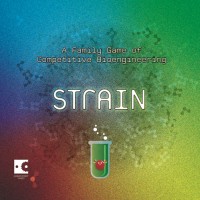
Strain
Overview
Strain brings the world of organisms, viruses and bioengineering to your table in a very fun way. The game is very contagious, but don’t worry, you won’t be catching the viruses! (Don’t forget to check out the publisher’s tutorial videos in the videos tab above)
Gameplay
Your goal is to complete enough organisms to be the first to score 12 victory points. The turns are simple; draw three tiles, build up your organisms and/or attack other players, score completed organisms and then discard down to four tiles.
There are three different types of tiles; Organism, Cytoplasm, and Petri Dish tiles. You can play one organism and cytoplasm card for free each turn, but the Petri Dish tiles usually require resources to play.
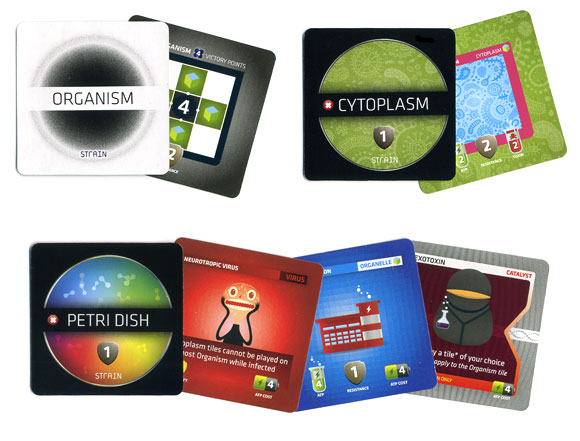
Building up your organisms serves two purposes:
1) The tiles you attach to your organisms will provide you with resources (ATP and Toxin), defense and special abilities.
2) Each organism requires a certain amount of attached tiles in order to score it. When you score an organism you must discard all of its attached tiles, so you may want to keep it around for it’s resources and score it later in the game.
It is the Petri Dish tiles that add the extra fun, excitement and unpredictability to the game. There are three types of Petri Dish tiles: Viruses, Organelles and Actions. The ATP cost to play these cards is in the lower right corner.
Viruses
You can play viruses on another player’s organisms to stop them from being able to score the organism until they’ve destroyed the virus. Viruses can also have other nasty affects. Giving someone a virus can give you that extra turn to plan for an attack, or complete your own organisms for the win!
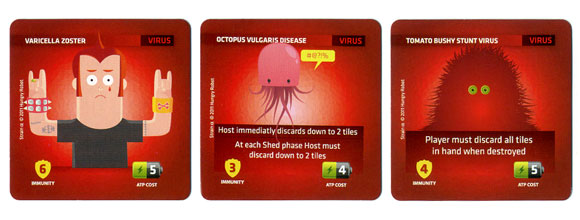
Organelles
These tiles can be attached to your organisms. They not only count towards completing your organisms but they can also give you resources, bonuses and special abilities.

Actions
These allow you to do unexpected things during your turn and other players’ turns. Things like stopping another player’s action from happening, gaining bonus defense during an attack, giving extra toxin to another player’s attack (when they are attacking someone other than you!), and much more.
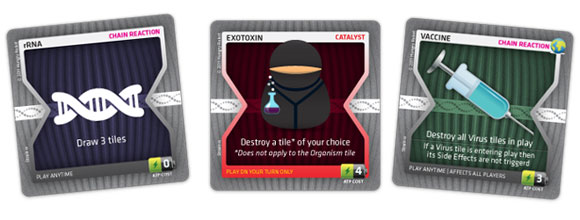
![]()
Resource management & defense
The resource management mechanics in the game are its bread and butter. How well you do is dependent on how well you manage your resources. The two types of resources are ATP and Toxin. ATP is what allows you to play Petri Dish tiles. Toxin allows you to attack and destroy other organisms.
Each tile (aside from viruses) that you attach to your organism will have a certain amount of defense (typically one, two or three defense). When you use the resources those tiles provide, you must flip them over to their “dormant” state. By doing this their defense is dropped to one until the beginning of your next turn. If other players have lots of toxin, or decide to gang up on you, it’s very likely your weak organism will be destroyed before your next turn.
Tip: You can turn your organism in for victory points even if its attached tiles are in their dormant state. Before you score an organism, make sure and use up all of its resources first to play more cards or attack other players… every little bit helps!
With a large group the game can get quite exciting, and you’d be wise to get involved verbally with what players are doing. Convincing someone to attack another player instead of you is quite handy, just be careful HOW vocal you are because sometimes that makes you the center of attention and likely to get attacked. If you’re playing with the full seven players, you DO NOT want to draw negative attention to yourself!
Components
The game is made up of 220 square cards (referred to as tiles), and some cardboard tokens to help aid players while they are trying to determine where to take the damage during an attack.
The rules are very well designed and laid out, making it very easy to learn the game. You’ll want to have it nearby the first few times you play so you can quickly reference it when you have a question. The official website also provides videos and FAQs to help with some of the more technical situations. There’s even a free downloadable print-and-play expansion!
The great thing about this game is each tile has a name that uses real science terms with illustrations and support text that are fun and humorous. The game is in no way confusing or too intellectual. There is an extra dose of humor if you already know what the names mean. I found myself looking up the definitions for fun, leading me to think this could be a great family game with an educational side to it.
The box says 3-7 players… can I play with just two?
When I was learning the rules for this game, my wife and I took it for a spin, even though it is a 3-7 player game. I was pleasantly surprised that the game is playable with two players. Just know that you’ll eventually discover strategies that make a two-player game difficult for either player to win because you’re both the only target for each other’s viruses and attacks. There are some two-player variant rules in our tip section.
Who would enjoy this game?
Final Thoughts
Strain doesn’t feel like any other game we’ve played. Yes there are games with tile placement, resource management, attacking and defending, cards with special abilities… but Strain brings all of these elements together in a fresh and fun way.
The mechanics and cards have depth, yet the rules are simple. Those elements, along with its scientific theme, humor and fun art style give Strain the makings of a great gateway game.
User Reviews (0)
Add a Review for "Strain"
You must be logged in to add a review.

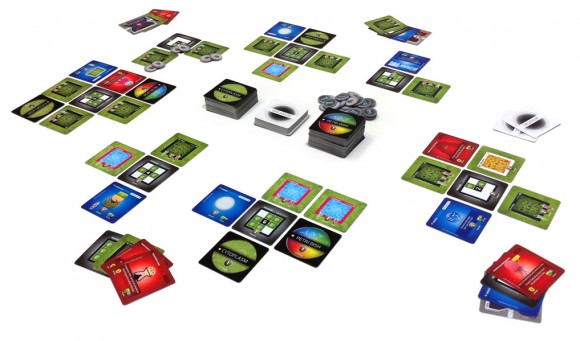


Be the First to Add a Review!